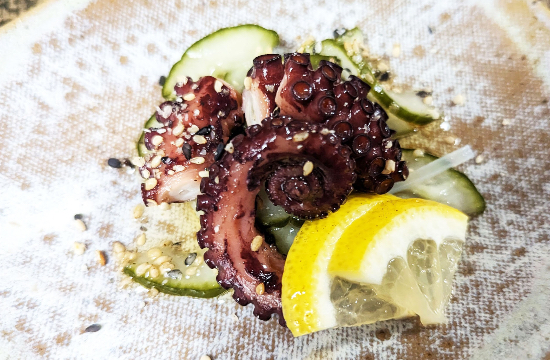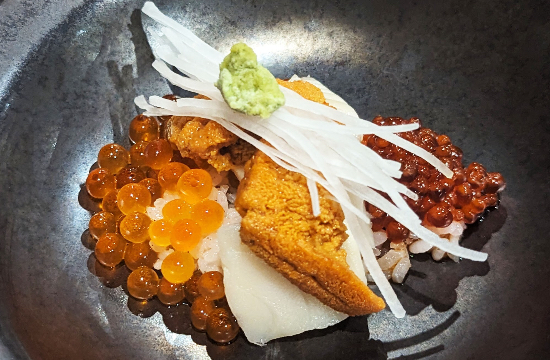BY SHELBY TUTTLE
Tucked away inside a modest strip mall just north of Detroit in Clawson, Michigan, Chef Hajime Sato is carving out a unique niche amidst a culinary landscape often defined by tradition and familiarity. Recently recognized as Best Chef: Great Lakes by the James Beard Foundation for his distinctly unconventional approach to sushi, his commitment to sustainability is truly what sets him apart. His journey, spanning three decades and two cities, is a testament to his unwavering passion for both culinary excellence and environmental responsibility.
Sato discovered his love for cooking while working a part-time restaurant job in Seattle during college. His initial foray into the industry was meant to be temporary, but it quickly evolved into a lifelong passion.
“I’m still doing [the] temp job,” he jokes. In 1994, Sato opened the successful Mashiko in Seattle — a revered spot for sustainable sushi in the Pacific Northwest. But his journey to sustainability was long and remains arduous to this day. As he honed his skills and gained experience, Sato became increasingly aware of the unsustainable practices prevalent in the seafood industry. He began to ask questions.
“How is [the fish] cut? Where does the water come from? Do they use slave labor? Do they use a round hook or J hook? What kind of long line do they use?” he said. Shocked by the revelations about endangered species and harmful fishing practices, in 2009, he made a bold decision to adopt sustainable initiatives and ethical sourcing within just three months.
“All the people, including sustainable seafood experts, said, ‘That’s crazy, you should wait a little bit longer,’” he recalls. “Like, no. No. No. I need to do what I have to do. Unfortunately, nobody really does it.”
Despite the positive publicity and accolades he received for his commitment to sustainability, Chef Hajime’s restaurant experienced a significant drop in sales as customers accustomed to traditional sushi options struggled to adapt.

“Within several months, we were featured in a lot of magazines and stuff that say, you know, ‘They’re sustainable, you’re great, yay!’” he said. “But instead of getting more traction or customers, sales went down about 20% immediately.”
Sato points out that a handful of seafood suppliers control what we see on sushi menus across the U.S., and the products you find in towns known for fresh seafood, like Seattle, are by and large the same products that you’ll find in restaurants in Phoenix, New York, or Chicago. Sato cryptically alludes to the story behind the rise of sushi in the U.S., driven by former Unification Church Leader and True World Foods founder Rev. Sun Myung Moon.
“Sushi itself (across the U.S.) is basically exactly the same, right? Because two or three big corporations distribute everywhere in the United States. Most of the chefs get most of the stuff from one or two distribution (points)…one shop, one stop, one phone call, everyone is gonna just get the same thing,” he says. “It may be a touch easier [to do sustainable sushi] in Seattle, but still hard because you’re going against the big corporation.”
In 2019, Chef Hajime and his wife relocated to the Detroit metro area, where he opened his restaurant, Sozai, with the same steadfast dedication to sustainability that had defined his career in Seattle. However, he quickly encountered new obstacles in sourcing sustainable seafood in the Midwest.
“I have to source a lot of things and ship it FedEx overnight to my house sometimes because there’s not that much big distribution trying to produce sustainable seafood or, you know, any kind of seafood I want,” he laments.
At Sozai, Chef Hajime notes that five omakase options make up roughly 80% of his business. Omakase, which means, “I leave it up to you,” is an often adventurous experience dictated by the freshest and best ingredients available to the chef. Because sustainability and availability are the primary informers of Sato’s menu, he notes that some of his dishes are “way too weird” for most customers.

“I’m serving invasive sea snails. I’m going to get you barnacles. I’m going to get maybe, like, a local smelt. Whatever it is, they’re not expecting it,” he says. “If I put that on the menu, nobody’s gonna order it. But if it’s omakase, if it’s my choice, then I’m gonna introduce that to you.”
Sato notes that it’s often hard for customers to appreciate his cuisine, referring to the typical oft-requested omakase menu items like rare bluefin tuna or certain caviars. It is in the pitfall of popularized sushi expectations that customers find difficulty in his menu.
“Most of the time, they don’t say it, but they’re looking for a completely different thing. They probably want spicy tuna, california roll, that kind of thing,” he says. “Sometimes I get yelled at, or they tell me that I don’t know anything about sushi because I’m not doing the spicy rolls. It’s a battle every single day.”

Despite these challenges, Chef Hajime remains committed to his mission, emphasizing the importance of educating his customers about the choices they make and the impact they can have on the environment.
“Don’t get me wrong, there are some customers who understand it, who get it, and I get a good conversation. I love it. I’m really excited about those things.”
And although the restaurant has seen its fair share of less- adventurous diners, it seems that Sato may be developing a bit of a return following for a menu that prioritizes ingredients that are sustainable, in season, and prepared with the least amount of intervention.
“Japanese cooking is all about how less we do,” he says. “If you put the butter on it or a dipping sauce, then you don’t taste the barnacles. Same with sea snails. I feel like chefs these days, they feel like they’re above the nature, which really frustrates me… We should think about what we killed, what we harvested, and think about what kind of flavor that ingredient wants us to taste.”
At the time of our interview, Sato’s 33-seat restaurant is booked for the next 30 days. Chef Hajime’s story is a reminder that even in a world dominated by convenience and the status quo, it is possible to make a difference. His relentless commitment to sustainability and his pursuit of culinary excellence serve as an inspiration to make conscious decisions about the food we consume and to support businesses that prioritize ethical sourcing. As he continues to push the boundaries of sustainable sushi, Chef Hajime is helping to pave the way for a more sustainable future — one ‘weird’ dish at a time.






